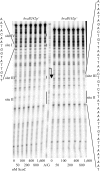Intermediate Levels of Bacillus subtilis CodY Activity Are Required for Derepression of the Branched-Chain Amino Acid Permease, BraB
- PMID: 26473603
- PMCID: PMC4608796
- DOI: 10.1371/journal.pgen.1005600
Intermediate Levels of Bacillus subtilis CodY Activity Are Required for Derepression of the Branched-Chain Amino Acid Permease, BraB
Abstract
The global transcriptional regulator, CodY, binds strongly to the regulatory region of the braB gene, which encodes a Bacillus subtilis branched-chain amino acid (BCAA) permease. However, under conditions that maximize CodY activity, braB expression was similar in wild-type and codY null mutant cells. Nonetheless, expression from the braB promoter was significantly elevated in cells containing partially active mutant versions of CodY or in wild-type cells under growth conditions leading to intermediate levels of CodY activity. This novel pattern of regulation was shown to be due to two opposing mechanisms, negative and positive, by which CodY affects braB expression. A strong CodY-binding site located downstream of the transcription start point conferred negative regulation by direct interaction with CodY. Additionally, sequences upstream and downstream of the promoter were required for repression by a second pleiotropic B. subtilis regulator, ScoC, whose own expression is repressed by CodY. ScoC-mediated repression of braB in codY null mutants cells was as efficient as direct, CodY-mediated repression in wild-type cells under conditions of high CodY activity. However, under conditions of reduced CodY activity, CodY-mediated repression was relieved to a greater extent than ScoC-mediated repression was increased, leading to elevated braB expression. We conclude that restricting increased expression of braB to conditions of moderate nutrient limitation is the raison d'être of the feed-forward regulatory loop formed by CodY and ScoC at the braB promoter. The increase in BraB expression only at intermediate activities of CodY may facilitate the uptake of BCAA when they are not in excess but prevent unneeded BraB synthesis when other BCAA transporters are active.
Conflict of interest statement
The authors have declared that no competing interests exist.
Figures









Similar articles
-
Role of branched-chain amino acid transport in Bacillus subtilis CodY activity.J Bacteriol. 2015 Apr;197(8):1330-8. doi: 10.1128/JB.02563-14. Epub 2015 Feb 2. J Bacteriol. 2015. PMID: 25645558 Free PMC article.
-
Interactive regulation by the Bacillus subtilis global regulators CodY and ScoC.Mol Microbiol. 2015 Aug;97(4):698-716. doi: 10.1111/mmi.13056. Epub 2015 Jun 6. Mol Microbiol. 2015. PMID: 25966844 Free PMC article.
-
Interplay of CodY and ScoC in the Regulation of Major Extracellular Protease Genes of Bacillus subtilis.J Bacteriol. 2016 Jan 4;198(6):907-20. doi: 10.1128/JB.00894-15. J Bacteriol. 2016. PMID: 26728191 Free PMC article.
-
CodY, a master integrator of metabolism and virulence in Gram-positive bacteria.Curr Genet. 2017 Jun;63(3):417-425. doi: 10.1007/s00294-016-0656-5. Epub 2016 Oct 15. Curr Genet. 2017. PMID: 27744611 Review.
-
The CodY pleiotropic repressor controls virulence in gram-positive pathogens.FEMS Immunol Med Microbiol. 2011 Jul;62(2):123-39. doi: 10.1111/j.1574-695X.2011.00812.x. Epub 2011 May 27. FEMS Immunol Med Microbiol. 2011. PMID: 21539625 Review.
Cited by
-
Systematic engineering of branch chain amino acid supply modules for the enhanced production of bacitracin from Bacillus licheniformis.Metab Eng Commun. 2020 Jun 11;11:e00136. doi: 10.1016/j.mec.2020.e00136. eCollection 2020 Dec. Metab Eng Commun. 2020. PMID: 32637317 Free PMC article.
-
Bioinformatics Modelling and Metabolic Engineering of the Branched Chain Amino Acid Pathway for Specific Production of Mycosubtilin Isoforms in Bacillus subtilis.Metabolites. 2022 Jan 24;12(2):107. doi: 10.3390/metabo12020107. Metabolites. 2022. PMID: 35208182 Free PMC article.
-
A Nutrient-Regulated Cyclic Diguanylate Phosphodiesterase Controls Clostridium difficile Biofilm and Toxin Production during Stationary Phase.Infect Immun. 2017 Aug 18;85(9):e00347-17. doi: 10.1128/IAI.00347-17. Print 2017 Sep. Infect Immun. 2017. PMID: 28652311 Free PMC article.
-
Systems Level Analyses Reveal Multiple Regulatory Activities of CodY Controlling Metabolism, Motility and Virulence in Listeria monocytogenes.PLoS Genet. 2016 Feb 19;12(2):e1005870. doi: 10.1371/journal.pgen.1005870. eCollection 2016 Feb. PLoS Genet. 2016. PMID: 26895237 Free PMC article.
-
Repression via DNA looping by the Gram-positive global transcriptional regulator ScoC from Geobacillus.Commun Biol. 2025 Jul 26;8(1):1111. doi: 10.1038/s42003-025-08555-1. Commun Biol. 2025. PMID: 40715536 Free PMC article.
References
Publication types
MeSH terms
Substances
Grants and funding
LinkOut - more resources
Full Text Sources
Other Literature Sources
Molecular Biology Databases

